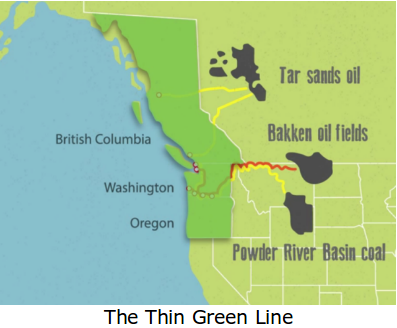
The Thin Green Line – an enigmatic, yet intuitively charged, descriptor of the ecological organizations in the Pacific Northwest that are engaged in near heroic struggles against fossil fuels. The involved activists consist of environmental groups, Native tribes, think tanks, community empowerment groups, public interest law firms, and others. They aren’t necessarily working as a unit, though their causes overlap, and they often collaborate on large issues. But collectively they are The Thin Green Line, and have a cumulative impact blocking tar sands oil, fracked shale oil, natural gas, and coal from reaching export terminals on the Pacific coast. Two of the key players are the Sightline Institute that ties issues and groups together with research and news, and the Columbia Riverkeeper that acts on many levels of river protection, legislative efforts, and regulatory challenges. The Sightline Institute maintains the website of The Thin Green Line.
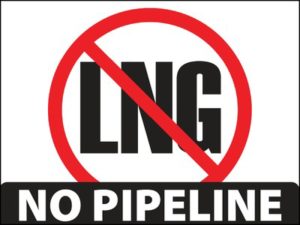
As their website says “The Pacific Northwest stands squarely between the most voracious energy markets in the world and huge fossil fuel deposits in the interior of North America — Powder River Basin coal, Bakken shale oil, Alberta tar sands, and remote natural gas fields”. The region itself doesn’t have much in the way of energy deposits for export, but it can act as gatekeeper. The ports of the states of Oregon and Washington and the province of British Columbia are absolutely essential for Big Energy to sell their carbon-intense fuels to Asian markets. Climate and ecological activists recognize these ports to be strategic choke points. By controlling the ports, they can seriously bottle up the energy. It’s a Thin Green Line they have drawn in the sand.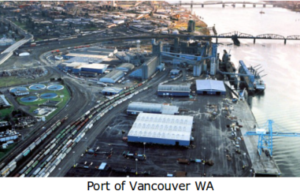
Success comes from persistence more than anything. Community organizers have a saying “Developers always come back”. It’s like a game of whack-a-mole. Corporations are all about profit, and their money must not be idle, but invested in active pursuits. So if they are thwarted at one turn, they always seek another approach – a different pipeline route, a more compliant town, a stronger legal argument. They must be beat back repeatedly. Some of these battles have taken 12 years or more of filings and hearings and court appearances. Victory under such circumstances takes persistence that comes only from passion, such as love of a river, or the beauty of community.
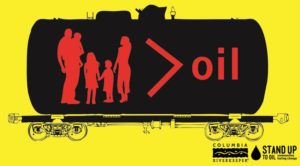
A couple recent successes of the Thin Green Line have been Fracked Gas-to-Methanol Refinery Permit Ruled Invalid, and Portland’s Landmark Fossil Fuel Policy Ruled Constitutional. Big or small, each victory adds up. One of the more notable victories was the Failure for Giant Tesoro Oil Train Terminal. Tesoro Oil had proposed to build North America’s biggest oil train depot within blast radius of downtown Vancouver WA on the Columbia River. The Tesoro Savage terminal was the last remaining undecided project of at least a dozen export proposals. Prior to this, other proposals were defeated by community opposition – Clatskanie, Longview, Grays Harbor, Tacoma, Anacortes, and Whatcom County. Tesoro’s case was fought for years, recently through a series of hearings before the Washington Energy Facility Site Evaluation Council (EFSEC). On 28 November 2017, EFSEC unanimously recommended denial of the Tesoro Savage oil terminal. Governor Jay Inslee had then to make the final decision, and he denied the permit on 29 January 2018 – Failure for Giant Tesoro Oil Train Terminal. One might say that The Thin Green Line tied the knot on this one. But they always come back. Here’s one that you may want to help out with – Fight Fracked Gas! Protect the Columbia!.
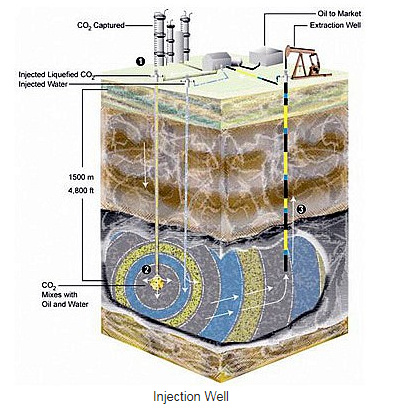
The Kansas and Missouri River Watersheds are precious natural resources that provide essential Ecosystems services to the region. They are increasingly seeing the impact of unsustainable pumping, irrigation, deforestation, agrochemical pollution, CAFO’s, industrial waste, sewage overflows and effects of climate change.
Three major regional issues; oil field injection wells in eastern Kansas, nitrate contaminated water dumping into the Kansas River, and the proposed Tyson chicken factory in Tonganoxie KS. have galvanized concerned citizens and organizations to come together so their voices can be heard by local, state and Federal policy makers and regulators.
Sustainability Action Network has brought together Kansas Water Protectors, active in the various environmental and citizens groups in Wyandotte, Leavenworth and Douglass Counties.
To help you learn the background, here are articles that ran in the Sustainability Action Newsletter.
OIL-FIELD WASTEWATER INJECTION WELLS IN DOUGLAS COUNTY: BACK TO SQUARE ONE
We reported last week that Midstates Energy Operators had posted public notice of their applications for wastewater injection wells at two locations near Eudora KS, Douglas County. The company, which is a stand-in for the property owners, was too complacent about due process, and mis-stated the protest period as 15 days instead of the required 30 days for environmental concerns. So the Kansas Corporation Commission (KCC) has required Midstates to republish the notices all over again. That means that the public has another bite at the apple, with another 30 days to send protest to the KCC. The new deadline is Saturday, 25 November 2017. Protest can be sent to:
Kansas Corporation Commission
Attn: Rene Stucky
Conservation Division (Oil & Gas)
266 N. Main St., Ste. 220
Wichita, KS 67202-1513
Although injection wells are commonly used to dispose of fracking wastewater, this is not the case here. The southeast part of Douglas County has old oil fields that produce with difficulty, so they are resorting to “enhanced recovery” technology to force more petroleum to the surface. Fresh water mixed with CO2 is forced into the oil bearing rock strata, and the CO2 volatilizes the oil so it flows to the oil extraction well. The water that comes up with the oil is then disposed of under high pressure in deep injection wells. There are three concerns about injection wells associated with petroleum and gas drilling. The most common one is the high potential for triggering earthquakes in unstable geologic formations. The Kansas Geological Survey links earthquakes to fracking waste disposal, and has increased restrictions as a result of the 2016 earthquakes in southern Kansas. A second concern is the potential for the deep-injected waste water to migrate into freshwater aquifers. And the third concern is the potential for the brine wastewater to cause land subsidence and sink holes near the oil fields – Brine Disposal, Land Subsidence, Salt Dissolution: Oil and Gas Operations.

The following are the specific oil field leases which have permits applied for. The two adjacent properties are southwest of Eudora, and three miles south of the K-10/Dg. Co. 1057 Rd. interchange.
-
One is the Thrasher Lease on the Mr. Pat Thrasher property, N.E. of the intersection of Dg. Co. 1057 Rd. and 458 Rd. The permit application is to “amend the injection well permit #E-31,965, Thrasher #10, Thrasher I-5, on Sec. 25, Twp. 13S, R 20E, Douglas County, Kansas”. Protest letters must reference that exact description.
-
The other is the Hadl Lease on the Mr. Vernon Hadl property, S.E. of the intersection of Dg. Co. 1057 Rd. and 458 Rd. The permit application is for “enhanced recovery of injection wells under permit #E-32,566, Hadl I-1 and Hadl I-2, on Sec. 36, Twp. 13S, R 20E, Douglas County, Kansas” Protest letters must reference that exact description.
You should receive acknowledgement from the KCC that they received your letter. But if you want to be legally certain, mail it Certified/Return Receipt. Once the protest period closes, the KCC will probably schedule a hearing on the permits – most likely in Topeka. Anyone who submitted a letter of protest is entitled to testify at the hearing.
LAWRENCE TO DUMP 30 MILLION GALLONS OF NITRATE CONTAMINATED WATER INTO THE KAW

Last Friday, 10 November 2017, a local newspaper article proclaimed that the Kansas Department of Health and Environment (KDHE) would allow Lawrence to dump up to 30 million gallons of nitrate contaminated water into the Kansas River. The water is a result of an admirable project of Lawrence, that of cleaning up the brownfield site of the Former Farmland Fertilizer Factory on the east side of town, and building the Venture Business Park (VBP) there. Decades of production of ammonia nitrate fertilizer had contaminated the soil and groundwater. And when Lawrence took ownership of the 467 acre site for free as part of a legal settlement, they also assumed liability for cleaning up what they thought would cost $13 million. But instead of giving the City Commission a really sweet deal, the former City Manager led them into a quagmire, and then hightailed it to Colorado.
Rainwater and groundwater flowing through the site washes out some nitrates, the City pumps water out, temporarily stores it in huge tanks, and sends it by pipe north of the river to a number of farms that have been using it to fertilize their crops. Straightforward and easy, right? Well, several snags have interfered. For one, there is a $8.6 million trust fund for the project, and interest from that was intended to meet the $13 million overall cost. But half of that trust fund was mistakenly left in a non-interest bearing account, so now they’re short of funds. Also, they projected that new businesses coming to town to buy sites at Venture Business Park would help defray costs, but with no takers so far, the City is giving away land as a come-on for businesses. Finally, the City failed to secure long term contracts with local farms to keep taking the nitrate water, and now several farms have switched to crops that don’t need the water. So nitrate water is still being pumped, storage tanks are full, and the distribution pipe is flowing at reduced rate. The only solution that Lawrence officials could conceive of would be to carry about 10 million gallons of water in about 1480 truckloads to nearby farms, at a cost of about $400,000. And this would be only a temporary fix – VBP nitrate water update_City Mgr Report_3Oct17.

So to the rescue comes KDHE with their “solution to pollution is dilution” plan. “We’ve conditioned this discharge so that the river really assimilates the nitrogen load quickly and disperses it”, said Tom Stiles, assistant director of the KDHE Bureau of Water. They claim that the mere 500,000 gallons per day is just a drop in the ocean, but it’s commonly known that the myriad nitrate discharges from all over the middle-continent river basin cumulative causes the Gulf of Mexico Dead Zone. And nitrates in drinking water also cause human health problems, the most serious being blue baby syndrome which can be fatal. City water treatment does not remove nitrates, and most home water purification systems do not either – State authorizes Lawrence to release up to 30 million gallons of nitrogen-contaminated water into Kansas River.
The City of Lawrence is saying the river discharge is not significant, and that they have heard nothing from the citizens regarding this situation. It’s no wonder they haven’t heard anything about this from the citizens, because all communications have been restricted to the City Manager’s report at the end of City Commission meetings. It wasn’t until last Friday’s newspaper article that anyone, other than the most ardent followers of City affairs, had heard anything about the plan. For that matter, none of the City Manager’s reports even indicated any plan at all except for the trucking option – VBP nitrate water update_City Mgr Report_5Sept17. The only hint that KDHE might bend the rules was statements like “The city has also requested additional guidance from KDHE”, and “The City has proactively engaged the Kansas Department of Health & Environment in assisting with the matter”. Inside sources have indicated that KDHE offered the discharge option to Lawrence. Both parties are now pointing fingers at each other with regard to who made the actual decision to discharge to the Kaw. Neither wants to acknowledge the responsibility.
It’s an open question as to how long ago the Kansas River discharge option may have actively, though quietly, been considered. According to Tom Stiles of KDHE, the nitrogen water will be released to the river via existing infrastructure of ditches and culverts. Is it just a puzzling coincidence that for the past six months, Douglas County stormwater crews have been dramatically enlarging two culverts under roads and the drainageway itself, directly north of Venture Business Park to where it empties into the Kansas River? Thousands of cubic yards of dirt have been dredged from the creek and trucked up to VBP where it is stockpiled in a virtual mountain. Or did the newly enlarged drainage ditch simply give officials the serendipitous ability to use the river discharge option?
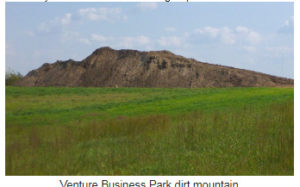
Venture Business Park dirt mountain
Citizens now in the know may be raising these questions and others about transparency, percent nitrate concentration in the discharge, if and how much the existing river discharge permit may need to be expanded, what evidence they will review from downstream impacts, and what bearing the Clean Water Act may have on this plan. In any case, if someone wants to question City officials, they can be contacted at – Lawrence City Commissioners , and City Manager, Tom Markus at <tmarkus@lawrenceks.org>. Also, the City Commission meets Tuesdays at 5:45pm at City Hall, with a public comment period at the beginning of each meeting.
EXTENT OF TYSON CHICKEN FACTORY, AND DEPTH OF OPPOSITION
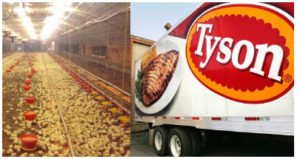
As Tyson Foods announced on 5 September, they plan to build a $320 million poultry processing plant south of Tonganoxie KS, with a start up date in mid 2018. The slaughterhouse would be on 300 acres, and process 1.25 million birds per week. In addition, Tyson would set up what they call “growout complexes” under contract with independent operators, commonly referred to as poultry houses or chicken factories. There would be about 40 of these farms within a 50 mile radius of Tonganoxie, where up to 30,000 chicks would be hatched and raised in each of the confined animal feeding operations (CAFOs), and then trucked to the Tonganoxie slaughterhouse. The impact on Tonganoxie and surrounding communities would include: air pollution from dust, ammonia, and other chemicals; water pollution of groundwater and streams; fish kills; liquefied animal waste containing E. coli and excess antibiotics spread on farm fields; damaged roads due to heavy CAFO semi-truck traffic; dehumanizing and injurious working conditions; and increased healthcare costs from polluted water, and arsenic and salmonella in processed chicken – Environmental Impact of Factory Farms.

Tyson is the largest U.S. producer of broiler and layer chickens, and they have a very long criminal rap list. They have more than 100 violations of EPA and USDA regulations, including toxic air releases, as well as 20 felony violations of the Clean Water Act. Equally worrisome are the satellite growout complexes throughout the region which are subject to a checkerboard of code provisions and regulations, or exempt depending on the locale. Tyson assumes no liability for these independent contractors, making enforcement fall upon the backs of local officials and taxpayers. Just this past March 2017, a Tyson-contracted chicken factory in Lincoln County TN suffered an outbreak of lethal H7 avian influenza (bird flu), also called highly pathogenic avian influenza (HPAI). It’s also highly contagious, requiring the immediate killing of all 73,500 birds in the facility, and placing under quarantine, along with approximately 30 other poultry farms within a 6.2-mile radius of the site. This is not an uncommon occurrence. In 2014 and 2015, during a widespread outbreak of HPAI, the United States killed nearly 50 million birds, mostly egg-laying hens. Learn more at – Bird flu outbreak at Tennessee poultry farm confirmed after chicken deaths.
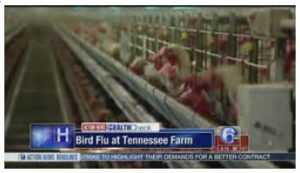
Folks in Tonganoxie, Leavenworth County, and surrounding counties are no slouches though. Within days, a group called Citizens Against Project Sunset (CAPS) had formed, and on Saturday, 8 September, CAPS held an opposition rally that attracted more than 1000 people. They had speakers, petitions to sign, flyers and stickers and yard signs, and computers set up to build a data base. Other groups are working with them including the Socially Responsible Agricultural Project out of Nebraska, and CleanAirNowfrom Kansas City. This past Friday, on 15 September, another rally attracted some 2500 people where they had three Kansas Representatives in attendance, had an on-the-spot post card writing campaign, and had created a website and a Facebook page. They are in the process of becoming a tax deductible organization so that contributors will get a tax deduction, and they can raise enough money to hire an attorney. As one of the organizers said, “It’s amazing how much you can get done over your lunch hour!” To learn more, and/or join the effort, go to No Tyson in Tongie, or Citizens Against Project Sunset (CAPS) on Facebook.
For the Protecting Water panel discussion, these representatives from our sister organizations will be the panelists:
Dawn Buehler – Friends of the Kaw: Kansas Riverkeeper
Elaine Giessel – Kansas Sierra Club
Thad Holcombe – Water Advocacy Team
Rachel Jefferson – Historic Northeast Midtown Association
Karin Pagel-Meiners – Wakarusa Group – Kansas Sierra Club
Jessica Skyfield – Kansas Water
Eric Kirkendall, moderator – Sustainability Action Network
The evening will begin with a pot luck dinner at 6:00 pm sharp (arrive a little early with your dish). At 7:00 pm the kitchen will close, and we will welcome everyone and give an overview of water issues concerning our local communities. From 7:00-8:00 pm, after introductions, each of the panelists will describe the state of water as they see it, and how their organization is working to protect our waters for the common good. From 8:00-9:00pm, we want to explore how all of us can best work together as a team to define and spark action that will lead to substantive change. Each of the panelists and their organizations have distinctive approaches to these issues, and any potential actions will be more effective if we combine our efforts. We hope you will join us.
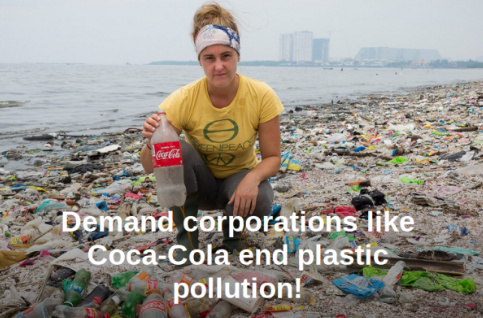
Who could have thought when we were growing up that soda pop would become a major water and environmental issue.
Last year, Greenpeace launched a campaign to get Coca Cola, Inc. to cut back on their use of single-use, throw away plastic bottles. Louise Edge, Senior Oceans Campaigner for Greenpeace, said “As the biggest plastic bottle producer, Coca-Cola has a special responsibility to lead the way in reduction of single-use plastic. The massive increase in plastic waste in our oceans, and increasingly in our food chain, is a result of our dependency on throwaway items like single-use plastic bottles”. According to Greenpeace, Coca-Cola produces over 110 billion throwaway plastic bottles every year – 3400 per second. Single-use plastic bottles now make up almost 60% of Coke’s global packaging, up 14% from 2008-2016. Coke set a target in 2013 that its recovery & recycling rates in developed countries would rise to 75% by 2020, but actual rates declined from 63% in 2013 to 59% in 2016. Most recently on 19 January 2018, Coca Cola released its new Global Plastics Plan. Greenpeace denounced the plan as being weaker than those previously announced for Europe, and because it failed to include any reduction of the company’s rapidly increasing use of single-use plastic bottles. Read more at – Greenpeace slams Coca-Cola plastic announcement as ‘dodging the main issue’ , and Fact sheet about Coca Cola’s bottle polution.pdf.
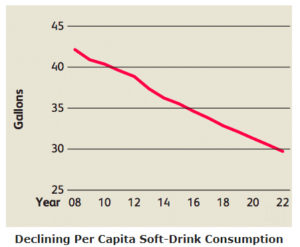
Coca Cola, and indeed all of the soft drink industry, has experienced a loss of market share in the last decade, mostly to bottled water. Sales of soft drinks has fallen every year since 2006. Derek Thompson of The Atlantic explained that the three soft drink “jobs” are now satisfied by other beverages. Growing numbers of people get their hydration from water, their energy jolt from coffee and energy drinks, and their fizzy fun from flavored seltzers, like LaCroix. Since 2000, bottled-water consumption has tripled – Diet Coke’s Moment of Panic. While the switch from sugary soda pop to water is a welcomed health improvement, the continued and growing use of single-use plastic bottles in no improvement at all.
A report from the Earth Institute of Columbia University noted that “In 2014, Americans discarded about 33.6 million tons of plastic, but only 9.5 percent of it was recycled. Most of the rest ends up in landfills where it may take up to 500 years to decompose, and potentially leak pollutants into the soil and water”. It’s estimated that there are already 165 million tons of plastic debris floating around in the oceans, including microplastics, tiny particles less than five millimeters long that harm or kill the marine wildlife that ingest it. A team of scientists from the University of Georgia, the University of California, and Sea Education Association calculated in 2017 that from 1950 until today, humans have generated 8.3 billion metric tons of plastics of all kinds. They confirmed that only 9 percent of it was recycled, while 79 percent was landfilled or else polluted the natural environment – Scientists calculate total amount of plastics ever produced.
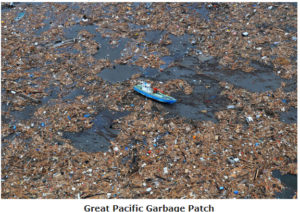
A key observation by the scientists is that plastics’ largest market is packaging, and most packaging is used once and discarded – such as single-use bottles. Plastics, of course, are petroleum, which carries it’s own ecological liabilities of drilling and tar sands mining, of pipelines and bomb trains, and of climate disruption. One of the best strategies for curtailing petroleum is to ban plastic packaging, and the best place to start is to ban plastic bottles. If you want to make a statement to ban the bottle, you may want to sign the Greenpeace petition – Demand big corporations do their part to end plastic pollution!.
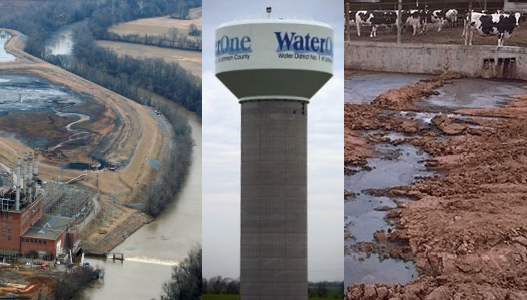
Friday, 2 February 2018, 6:00pm-9:00pm
Douglas County Fair Grounds, Dreher Building, 2110 Harper St., Lawrence KS 66046
The Sustainability Action 2018 Annual Meeting will host a panel discussion on “Protecting Water in Kansas: Quality and Availability”, with a local, regional, and state focus. The panel will consist of water activists who are leaders in their own organizations, and who draw upon varying perspectives for protecting our valuable waters. Our intent is to educate, inspire, bring additional people into the movement, collaborate, and mobilize to action. The following representatives from these groups will be the panelists:
Dawn Buehler – Friends of the Kaw: Kansas Riverkeeper
Elaine Giessel – Kansas Sierra Club
Thad Holcombe – Water Advocacy Team
Rachel Jefferson – Historic Northeast Midtown Association
Karin Pagel-Meiners – Wakarusa Group – Kansas Sierra Club
Jessica Skyfield – Kansas Water
Eric Kirkendall, moderator – Sustainability Action Network
Water is our most precious good, enabling and cleansing all life. Only 2.5% of Earth’s water is fresh – present in lakes, streams, aquifers, and the atmosphere. It is an all-encompassing concern, spanning the aspects of water quality, quantity, privatization, sea level rise, wars, and more. Water availability is threatened by drought, desertification, pollution, urbanization, overconsumption, and privatization. Water quality is threatened by our industrial society in several ways, from injection wells and fracking, to nitrate fertilizer and pesticide runoff, and pharmaceuticals and other toxins.

Most of the pollution and overconsumption can be traced to industrial activities such as fossil fuel extraction, petrochemical plants, power generation, urban lawn chemicals, and industrial agriculture. The cumulative result of all this is that our streams have become open sewers, aquatic ecosystems are compromised, aquifers are contaminated or threatened, crop failures are more common for both irrigating and subsistence farmers, cost of water treatment is rising, algae blooms trigger ocean dead zones, and there is a drinking water crisis in numerous cities nationwide.

The evening will begin with a pot luck dinner at 6:00pm sharp (arrive a little early with your dish). At 7:00pm the kitchen will close, and we will welcome everyone and give an overview of water issues concerning our local communities. Then after introductions, each of the panelists will describe the state of water as they see it, and how their organization is working to protect our waters for the common good. In the second hour, we want to explore how all of us can best work together as a team to define and spark action that will lead to substantive change. Each of the panelists and their organizations have distinctive approaches to these issues, and any potential actions will be more effective if we combine our efforts. We hope you will join us.
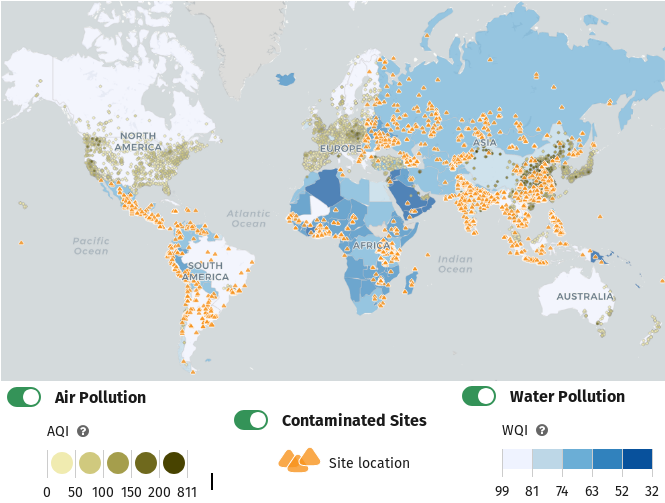
More than war and violence – more than smoking, hunger, or natural disasters – more than AIDS, tuberculosis, and malaria combined. More people are prematurely killed worldwide each year from polluted air and water, at least 9 million, than the total number of people who die every year from these other major killers. This data comes from an extensive study by the Lancet Commission on Pollution and Health that was released on 19 October 2017. The study found that one in six premature deaths, or 17 percent of the world population, are attributable to toxic exposure to environmental pollutants, and that the financial cost is about US$4.6 trillion, or about 6.2 percent of the global economy.
Lead author of the report, and Dean of global health at the Icahn School of Medicine at Mount Sinai, New York, Philip Landrigan, said “Pollution is a massive problem that people aren’t seeing because they’re looking at scattered bits of it”. The figure of 9 million pollution-related deaths is considered a low estimate by Commission researchers, who are projecting that the impacts will be better quantified with new assessment methods and new research.
As one might expect, “The vast majority of pollution-related deaths — 92 percent — occur in low- or middle-income countries, where policy makers are chiefly concerned with developing their economies”, according to the report. The continents of Asia and Africa have the worst incidence of toxin-induced premature deaths, and India tops the list with one out of every four premature deaths, or some 2.5 million, caused by pollution. And in the wealthier countries that have curbed much of the early occurrences of industrial pollution, it’s the lower class poor communities that still suffer from negligent corporate emissions and lax enforcement – the so-called environmental justice communities. As the article states, “According to the NAACP’s research, the percentage of African Americans in the fenceline zones near chemical plants is 75 percent greater than for the country overall; for Latinos, 60 percent”. Learn more at – Pollution Kills an Estimated 9 Million People Every Year.
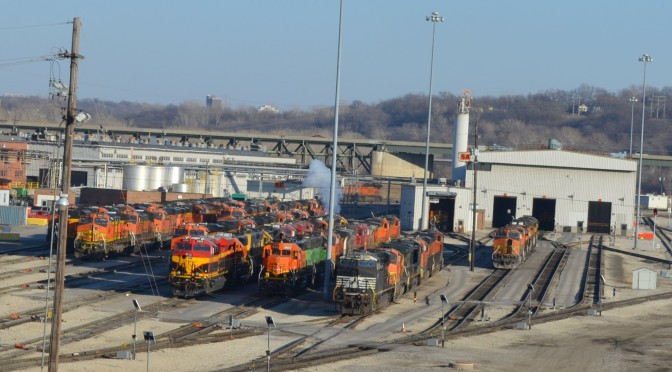
Sustainability Action Network is proud to introduce , CleanAirNow
CleanAirNow is dedicated to improving air quality in Kansas City and the surrounding region, particularly in communities suffering the greatest health burden, and to preventing and mitigating disease caused by air pollution.
CleanAirNow is a community-based and community-driven equitable partnership of community groups, educational, research, environmental, health, other organizations, and individual members.
Learn more and join at: http://cankc.org/
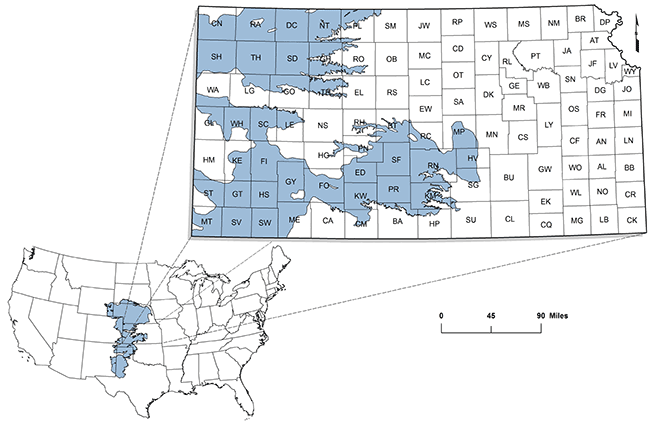
The Ogallala Aquifer (technically the High Plains Aquifer) underlies an area in eight states, of approximately 174,000 sq mi, being one of the world’s largest aquifers. 30,800 square miles of that is in western and central Kansas, 900 sq mi in Colorado, 20,600 sq mi in Texas, and it is under virtually all of the state of Nebraska. The aquifer stores as much water volume as Lake Huron (2.9 billion acre-feet). It provides 30 percent of the United States’ irrigation, contributing to an astounding 20 percent of the country’s entire agricultural output. The Ogallala water accumulated slowly over tens of thousands of years, and aquifer recharge occurs very slowly because of scant rainfall on the high plains. In most of the aquifer, except for Nebraska, the irrigation use by high water-demand crops like corn is far greater than the recharge rate. In Colorado alone, farmers pumped water out of 4,000 wells, sucking out as much as 500 gallons per minute per well.
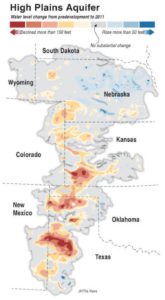
In western Kansas, farmers are drawing down their region’s groundwater at more than six times the natural rate of recharge. Kansas State University researchers found that 30 percent of the region’s groundwater has been tapped out. As underground water levels drop, pumping from a greater depth becomes more and more expensive, to the point of unprofitability. The advent of center-pivot irrigation systems in the 1960’s allowed people to irrigate uneven terrain, which opened up large new areas for water thirsty crops like corn. That led, in turn, to large feedlots and packing plants. The combination of corn for cattle feed, and corn for government subsidized ethanol production has driven a tripling of the price of corn since 2002, and Kansas farmers have responded by increasing the acreage of irrigated cornfields by nearly a fifth. This price bubble will burst when the Ogalla Aquifer drops so deep that pumping costs will become prohibitive. By then, the midwest will have become the Great American Desert. Learn more at – The real reason Kansas is running out of water, and Why These 8 States Could Soon Form the ‘Great American Desert’.

There are two kinds of wells used for fossil fuels: extraction wells to draw either petroleum or natural gas from geological formations, and injection wells to force liquids under high pressure deep down underground. Injection wells can be of three types. The first is to force saltwater mixed with CO2 into oil bearing shale to thin the oil so it will flow freely up an extraction well. The second is to force the saltwater that returns with oil to the surface back down into deep rock layers to dispose of it. And the third is to force fracking wastewater that returns with oil to the surface back down into deep rock layers to dispose of it.
Here are three concerns about injection wells associated with petroleum and gas drilling. The most common one is the high potential for triggering earthquakes in unstable geologic formations. The Kansas Geological Survey links earthquakes to wastewater disposal, and has increased restrictions as a result of the 2016 earthquakes in southern Kansas. A second concern is the potential for the deep-injected wastewater to migrate into freshwater aquifers. And the third concern is the potential for the brine wastewater to cause land subsidence and sink holes near the oil fields – Brine Disposal, Land Subsidence, Salt Dissolution: Oil and Gas Operations.
As far as we know, there is no fracking in Douglas County, all seemingly concentrated in the southern-most Kansas counties bordering Oklahoma. But there is petroleum in Douglas County in relatively small fields, and dozens, if not hundreds, of wells are scattered around the eastern part of the county. Most of these wells produce little, so operators are resorting to what is called “enhanced recovery” technology, or “tertiary recovery”. This amounts to applying pressure to the pockets of petroleum by injecting high pressure saltwater into the rock that dilutes the petroleum and forces it to the surface. A rash of these saltwater injection wells have come to the attention of the public recently, because operators must get permits from the Kansas Corporation Commission (KCC).
 In mid-October 2017, a contractor named Midstates Energy Operators filed applications with the KCC for saltwater injection wells on two properties southeast of Lawrence. There had been earlier applications, and permits granted in the general vicinity, as well as dozens south and east of there near Baldwin City, but only a few people knew of them. The KCC permit process is very opaque for the public in many ways, one such being that a “public” notice for an application need be published for only one day, and appears in the classified ad supplement, not the main newspaper. It so happened that a Sierra Club member noticed the two recent applications, and alerted others.
In mid-October 2017, a contractor named Midstates Energy Operators filed applications with the KCC for saltwater injection wells on two properties southeast of Lawrence. There had been earlier applications, and permits granted in the general vicinity, as well as dozens south and east of there near Baldwin City, but only a few people knew of them. The KCC permit process is very opaque for the public in many ways, one such being that a “public” notice for an application need be published for only one day, and appears in the classified ad supplement, not the main newspaper. It so happened that a Sierra Club member noticed the two recent applications, and alerted others.
The Midstates Energy Operators injection well applications are for two adjacent properties southeast of Lawrence and southwest of Eudora, three miles south of the K-10/Dg. Co. 1057 Rd. interchange.
-
One is the Thrasher Lease on the Mr. Pat Thrasher property, N.E. of the intersection of Dg. Co. 1057 Rd. and 458 Rd. The permit application is to “amend the injection well permit #E-31,965, Thrasher #10, Thrasher I-5, on Sec. 25, Twp. 13S, R 20E, Douglas County, Kansas”. Protest letters must reference that exact description. The KCC has issued to this case a main reference Docket Number of 18-CONS-3195-CUIC, and it can be viewed at Thrasher Docket Details.
-
The other is the Hadl Lease on the Mr. Vernon Hadl property, S.E. of the intersection of Dg. Co. 1057 Rd. and 458 Rd. The permit application is for “enhanced recovery of injection wells under permit #E-32,566, Hadl I-1 and Hadl I-2, on Sec. 36, Twp. 13S, R 20E, Douglas County, Kansas” Protest letters must reference that exact description. The KCC has issued to this case a main reference Docket Number of 18-CONS-3196-CUIC, and it can be viewed at Hadl Docket Details.
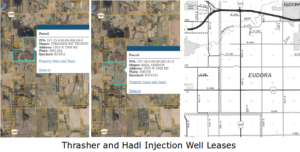
The public is encouraged to send protest letters (if so inclined) before the deadline of 27 November. The KCC ordered the applicant to republish the public notices with a correct protest window of 30 days. The technical deadline is Saturday, 25 November, but since the KCC is closed on weekends, the effective deadline is extended to Monday, 27 November. To be valid, protest letters must ARRIVE AT THE KCC OFFICES on or before the deadline (not the postmark date). The U.S. Postal Service won’t deliver on Thanksgiving, and the KCC will be closed from Thursday through Sunday. That means that letters must arrive at the KCC either by Wednesday, 22 November, or Monday, 27 November. Play it safe and aim for the 22nd.
 However – there now is an electronic way to file a protest letter. No postage, no delay, no uncertainty, and it works any day, holiday or not, including Saturday 25 November. Go to the KCC website E-filing link at – https://puc.kcc.ks.gov/e-filing/e-express/, where you can upload a PDF version of your protest letter (not a Word.doc version). Reference each application with the Docket Number, and put the Docket Number in your letter also. To get site access, you first must create a user name and a password, just like you might for Craig’s List or your kid’s school grades. E-filing is faster, no envelopes and stamps, and you get a notification back that your letter was received.
However – there now is an electronic way to file a protest letter. No postage, no delay, no uncertainty, and it works any day, holiday or not, including Saturday 25 November. Go to the KCC website E-filing link at – https://puc.kcc.ks.gov/e-filing/e-express/, where you can upload a PDF version of your protest letter (not a Word.doc version). Reference each application with the Docket Number, and put the Docket Number in your letter also. To get site access, you first must create a user name and a password, just like you might for Craig’s List or your kid’s school grades. E-filing is faster, no envelopes and stamps, and you get a notification back that your letter was received.
If using the U.S. Postal Service (or other delivery services), mail it to: Kansas Corporation Commission, Attn: Rene Stucky, Conservation Division (Oil & Gas), 266 N. Main St. Ste. 220, Wichita, KS 67202-1513. It’s best to mail letters Certified/Return Receipt, to get proof that a letter was delivered.
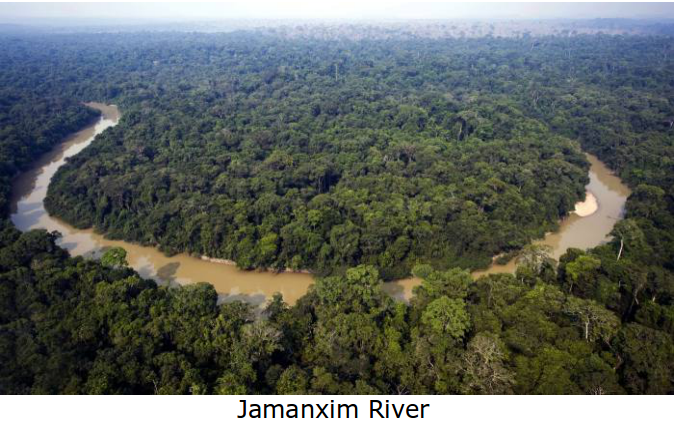
It may come to light that Trump gained occupancy of the White House fraudulently, and has presumed the power to wreak havoc on our environmental protections. But consider the parallel case in Brazil, different only in that the actors are more amateurish.
Michel Temur was installed as Interim President after his centrist Democratic Movement Party (PMDB) led the impeachment of President Dilma Ruosseff of the leftist Workers’ Party (PT). Temur and Senator Aécio Neves, who was Rousseff’s 2014 opponent in the presidential campaign, had accused Rousseff of taking illegal state loans to shore up a tanking economy. Though no proof was produced against Rousseff, she was impeached anyway. Now however, there has emerged hard evidence of criminality by both Temur and Neves. Neves was caught on tape requesting 2 million Reals from a businessman, and was removed from office by a Supreme Court ruling. Temer was caught on tape also, when endorsing ongoing bribes to maintain the silence of former House Speaker Eduardo Cunha, who presided over Dilma’s impeachment – After Latest Bombshells, Only Michel Temer’s Removal and New Elections Can Save Brazil’s Democracy.

Temur is Brazil’s most unpopular leader on record. While he is momentarily refusing to resign, his removal seems inevitable, as his key allies are starting to abandon him. But just like in the U.S. where a *president who some consider a moron is eliminating environmental “impediments” to corporate profits, in Brazil a president considered a felon is doing the same. Even when these two are gone, their damage will have been done. Most of Temur’s damage in Brazil is the decimation of the Amazon rainforest and its ability to sequester vast amounts of CO2, making the planet less livable for all of us. Globally, an estimated 7.8 BMtC (billion tons of carbon per year) come from fossil fuels and cement manufacturing, and 1.1 billion tons of carbon come from deforestation for agriculture. Forests and other plant communities currently sequester an estimated 2.6 BMtC, or 29% of total global emissions – The Great American Stand Report.pdf (page 10).
The Brazilian agricultural lobby was a key player in replacing Rousseff with Temur, so Temur is obliging their desires. With soybeans and beef cattle a large part of the Brazilian economy, agribusinesses and large landholders have been pushing through legislation to reverse longstanding protections for the rainforest. Temer is also fast-tracking major development projects that will lead to further deforestation, including hydroelectric dams and highways. On top of which, a 43% cut in the Ministry of Environment budget and 44% cut in science research budgets will reduce environmental law enforcement in Amazonia to virtually zero – Amazon rainforest under threat as Brazil tears up protections. More directly, Temur has proposed legislation to reduce the size of the Jamanxim National Forest by about 862,610 acres, or 27% (an area roughly the size of Portugal). He also has has abolished a vast national reserve of roughly 17,800 square miles (bigger than the size of Denmark) to open the area to commercial mining of gold, iron, and manganese – Brazil scraps Amazon reserve to allow mining.

Soybeans and cattle grazing form the backbone of Brazil’s agriculture sector, which is 5% of GDP, but a full 29% when processing and marketing is added in. The record soy harvest this year, plus a strong comeback in the corn harvest, has been credited with pulling the Brazilian economy out of a multi-year recession – Agriculture, a strategic sector for Brazil’s economic growth. Out of economic priorities, many concessions are being made to soy and meat producing interests, a major one being the opening of more land through deforestation. But due to opposition by conservationists, agribusiness giants like Cargill and Archer-Daniels Midland pledged not to deforests the Amazon, agreeing to an Amazon Soy Moratorium in 2006. However, large-scale soy growers simply moved their plantations to areas like the Cerrado Biome, a tropical savanna next to the Amazon Biome, with an enormous capacity for storing CO2 – Amazon deforestation linked to Cargill, McDonald’s and British retail giants. In an all too common scenario, the rainforest is at the mercy of the Brazilian and global economies.
On 23 October 2017, 92 of the world’s largest banks will meet in São Paulo, Brazil to recommit to the Equator Principles, a set of rules guiding which industries and projects they will and won’t finance. These so called “Equator Banks” have promised to avoid or minimize the social, environmental and climate impacts of such projects. But the currently worded principles are too vague to prevent banks from financing dirty oil, deforestation, coal, and mega-hydro dams. So a coalition of 65 environmental, human rights and Indigenous Peoples’ organizations are organizing a global action on 23-24-25 October. They are calling on the Equator Banks to completely revise the outdated Equator Principles to include an explicit commitment to the Paris climate goal of limiting global temperature rise to well below 2 degrees, and to include Indigenous People’s rights to Free Prior and Informed Consent (FPIC) before investment in projects on their lands. Learn more here – Equator Banks Called Upon to Act on Climate Change and Indigenous Peoples’ Rights. And you may then want to sign a petition to the Equator Banks here – Equator Banks, Stop Financing Climate Disasters and Respect Indigenous Rights.
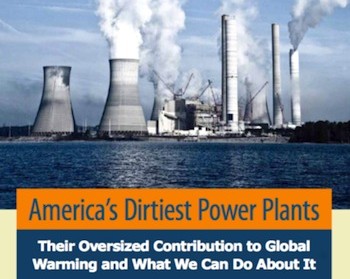
Of the world’s 500 biggest corporations, just 50 of them are generating 75% of the greenhouse gases from corporate sources. According to a 2013 article in the Sustainable Business Journal, “At least 17 of the worst 50 are U.S. companies, many of them in the oil industry: Exxon-Mobil, Chevron, Conoco-Phillips, Apache, Devon Energy and Occidental Petroleum. Other offenders include Carnival, Air Products & Chemicals, Dow Chemical, DuPont, Praxair, AT&T, American Electric Power, Duke Energy, and Exelon.” Some companies like Amazon and Apple declined reporting at all, while others gave only selective information to downplay their carbon footprint. For example, in the financial sector, just 6% disclosed emissions associated with their investments, which make up the majority of their emissions. Bank of America is a good example – it touts its environmental progress while continuing to invest in coal – 50 of the World’s 500 Biggest Companies Undermine Progress on Climate Change.
E & E News published a report in 2014 that quantified economically the societal costs of climate disruption, for anything from “sea-level rise, to extreme heat, and crop losses, that will cost the country several billion dollars annually in the decades ahead”. Of concern is who pays these costs? Costs from flooding, storm damage, wild fires, disease, and drought typically fall on the shoulders of emergency agencies, insurance companies, governments (taxpayers), or simply individuals. Such losses resulting from corporate actions are “externalized” off the company books into the public sphere, by way of denying cause and consequence – ‘Risky Business’ report puts climate costs at many billions of dollars annually.

But now in a 2017 study published by the Climatic Change Journal, the authors report that “Using a simple, well-established climate model, our study for the first time quantifies the amount of sea level rise and increase in global surface temperatures that can be traced to the emissions from the 90 largest carbon producing companies. We have the data needed to link the emissions traced to products sold by a fossil fuel company to a specific share of changes in temperature and sea level rise”. This is a sea change (pardon the pun). Exact costs of given climate disasters can now be pinned on the balance sheets of specific corporations! For example, they report that “More than 6% of the rise in global sea level resulted from emissions traced to ExxonMobil, Chevron and BP, the three largest contributors”. This data can be confidently used by governments to assess corporations for damages, or by individuals or communities to sue corporations for damages. In fact, “Lawsuits filed in July by three coastal California communities against ExxonMobil, Chevron, BP and other large fossil fuel companies argue that the companies, not taxpayers and residents, should bear the cost of damages from rising seas”. Read more at – Big Oil must pay for climate change. Now we can calculate how much.






















 In mid-October 2017, a contractor named
In mid-October 2017, a contractor named 
 However –
However – 




Recent Comments